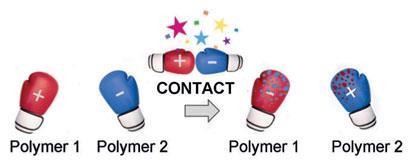Transfer of nanoscale fragments found to be far more important than previously thought for producing static charges
The charge that develops when two materials are rubbed together is dependent on tiny fragments of the materials transferring onto each other, say US scientists. The effect can even invert the normal polarity of the charging, so materials that would normally become positively charged can turn negative and vice versa.
Contact charging has provided hours of entertainment with balloons, hair and synthetic fibre clothing for generations. But it has also provided something of a headache for chemists attempting to rank materials into a ’triboelectric series’ relating their propensity to develop charge. As Bartosz Grzybowski from Northwestern University in Illinois explains, looking through the literature turns up a surprising number of irreproducible and contradictory results - even for the same pairs of materials.
Over the past few years, says Grzybowski, it has become increasingly clear that contact charging is much more related to the surface properties of an object than the bulk material from which it is made. While there is still debate over what carries charge between materials - whether it is electrons, ions or both - it has also emerged that nanoscale fragments of material are transferred from each material to the other, carrying their own charge with them.

’People had thought that this material transfer was probably only modifying charging to a small degree,’ says Grzybowski. ’We’ve shown that, actually, through material transfer you can change the overall polarity of the materials. So something that initially is charging minus, if you touch it a little bit more [with the charging material], it will become plus.’
’This really shows that there are at least two important mechanisms involved, and material transfer can’t be ignored,’ says Dan Lacks, who researches contact charging at Case Western Reserve University in Cleveland, US. ’The bad thing is it’s hard to control or predict how much it’s going to happen,’ he adds. ’In real life you’re often not starting with clean materials so you don’t know what they’ve touched or rubbed on.’
But it goes even further than that, says Grzybowski. Even the way the polymers are processed can affect how they charge. ’At one point we were studying Teflon beads from two different suppliers, and they turned out to behave totally differently,’ he says. His team have some preliminary results showing that the orientation and arrangement of the polymer chains is strongly affected by any surface charge on the mould they are made in.
It has taken a barrage of high-end analytical techniques to pin down these complexities. Grzybowski’s team used a combination of various kinds of atomic force and Kelvin probe microscopy, along with Raman and x-ray photoelectron spectroscopy, plus techniques to characterise the hardness and wear parameters of the different materials.
Grzybowski attributes these latest insights to a combination of new technology to examine the phenomenon at the nanoscale, and a little of the wisdom that comes with age. ’I did similar experiments 10 years ago with George Whitesides [at Harvard University, US]. Back then we agreed it was a nightmare and we should quit, because there was nothing we could correlate with anything else!’
Lacks agrees that while new techniques have played their role in recent developments, it is an influx of new ideas that has reinvigorated interest in tribocharging. ’Once new ideas come out, it motivates more people to test things,’ he says.
Phillip Broadwith
References
H T Baytekin et alAngew. Chem., Int. Ed., 2012, DOI:10.1002/anie.201200057






No comments yet